Fun Facts About Orthodontics
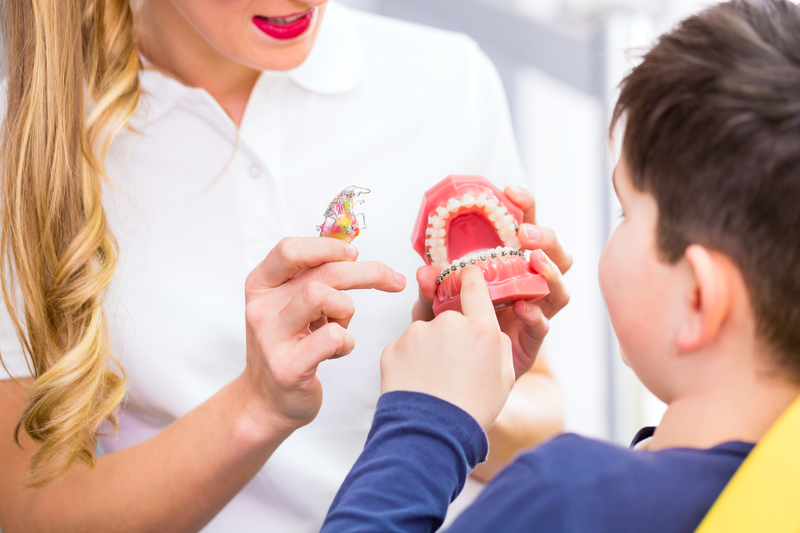
Did you know that an orthodontist is different than a dentist? Orthodontics is a dental specialty all its own, that has different goals and processes than what dentists do. There are many ways to fix the teeth and many methods that have been tried for many centuries. Find out the amazing history of orthodontics and some facts you may not know!
History of Orthodontics
People have been straightening their teeth since the time of the Ancient Egyptians, as can be seen from mummies from this era. Even the Romans and Etruscans used crude orthodontic straightening methods to get a better smile. Many philosophers hypothesized better ways to straighten the teeth. A Roman writer Celsus (1 A.D.) thought the teeth could be pushed into place. Pliny—around the same time—thought the teeth could be filed to be the ideal shape and size.
It wasn’t until 1728 that Pierre Fauchard—or the “Father of Dentistry”—made great strides with orthodontics. He first practiced crudely removing the teeth, replacing them straight, and tying them to other teeth so they could heal straighter. From his influence and others after him, modern orthodontics came to be. Matthaeus Gottfried Purmann developed dental impressions in the 17th century. In the early U.S. years, barbers and medical professionals experimented and performing small orthodontic treatments. This was until the first dental school was established in 1828.
Afterwards, J.S. Gunnell invented a form of headgear that was successful in straightening the teeth. Dental students and professionals figured out how to make a metal appliance to straighten individual teeth, which led to the now-used bracket and wire design in modern orthodontics. Before 1970, orthodontists wrapped wires around each tooth and required that headgear to straighten. This practice involved lots of metal in the mouth, which is why a better form (that we use today) was invented in the following years. Now, in the last 20 years lingual braces (braces behind the teeth) and Invisalign (transparent aligners) were invented to allow patients a hidden apparatus with orthodontics.
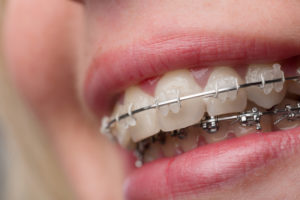
What Do Orthodontists Do?
Did you know that orthodontists are dentists? Every orthodontist is a dentist because they have completed dental school and then some. However, not all dentists are orthodontists. The standard requirements for dentists are to complete 4 years of undergraduate schooling and then 4 years at a dental school. They will have to pass exams and become certified to do dental work. Orthodontists do all of those 8 years, plus they complete 2-3 more years of orthodontics, training in bite and alignment correction and surgical orthodontics. All throughout their career, both dentists and orthodontists must do continuing education courses as well as pass tests to continue working.
An orthodontist will not fix your cavity even though they may spot the signs of tooth decay. Often, an orthodontist works closely with a dentist, as both professionals work on your mouth. What one professional doesn’t do, the other will do. Dentists do everything relating to tooth decay (cavities), gum disease and other oral health diseases as well as remedying dental emergencies. An orthodontist performs services that a dentist doesn’t do such as:
- Bite and alignment correction in children and adults (child orthodontics and adult orthodontics)
- Surgical orthodontics, which is surgery to help remedy a misaligned jaw or bite.
- Braces design, fitting, adjusting and complete process with lingual braces, ceramic (clear) braces, traditional metal, and Invisalign treatment.
- Training in placing temporary anchorage devices, which are tiny screws in the mouth that push, pull, lift or intrude teeth that are being straightened.
- Designing and creating retainer devices to keep bite, alignment and teeth in proper position.
Facts About Braces
- An orthodontist must complete 4 years of dental school, plus 3700 hours or specialized training in orthodontics to get their degree.
- There are more than 19,000 orthodontist members under the American Association of Orthodontics in the U.S., Canada and abroad.
- 1 in 4 people with braces are adults.
- Children make up another 1/4th of people wearing braces to correct bite and alignment.
- Because of modern technology, all four of your dental options (lingual, metal, ceramic and Invisalign) can straighten your teeth in about the same amount of time.
- It is possible to only get braces in either your upper or lower jaw if the other jaw is straight.
- The jaws stop growing as a child ages. That growth stops towards the end of the teenage years around 17 or 18. Straightening the teeth is effective for people after this age, but it may take longer than it would for children.
- Patients generally see their orthodontist every 6-10 weeks for braces adjustments. Patients with severe bite and alignment issues may need to come in more often.
- Orthodontists often usually have “DDS” or “DMD” after their names. This stands for “Doctor of Dental Surgery” and “Doctor of Dental Medicine”. Both are considered equal degrees, but the degree given depends on the dental school attended before orthodontic training.
- Materials used in metal braces are so light that they won’t set off metal detectors in airports.
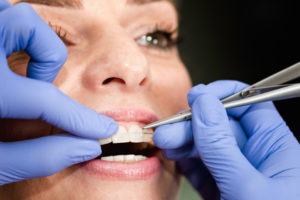
How Do Orthodontics Help People?
If you’ve never been to an orthodontist, you may wonder why you need one. Not everyone may need orthodontics to correct bite and alignment issues, but everyone should see an orthodontist at some point. The American Association of Orthodontics recommends that every person have an orthodontic visit between ages 7 and 8. This is prime time to detect bite and alignment issues that would lead to crooked teeth, speech impediments, oral hygiene diseases, and problems chewing, biting and functioning normally.
When issues are found, they can quickly be corrected so children can grow and develop normally. If a teen or adult wants to straighten their teeth to boost their confidence and success, they can receive braces starting around age 11. For specific questions about our orthodontic services, call Belmar Orthodontics today at (303 225-9016!
What Is an Orthodontist?
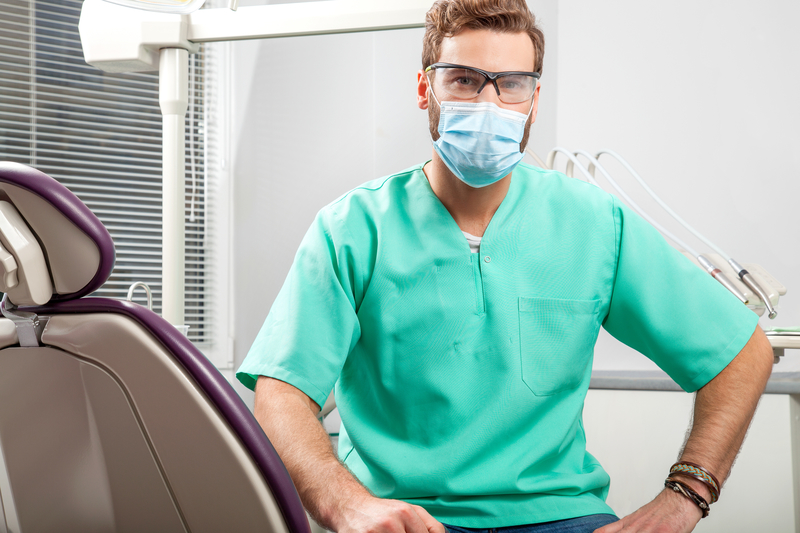
If you want to be an orthodontist, you have at least 10-12 years of schooling ahead of you. Orthodontists are very similar to dentists, but they perform completely different tasks in an office than a dentist would do. This is why you need to see both an orthodontist and a dentist if you have braces. See what services they provide that no one else can!
Want to Become an Orthodontist?
To become an orthodontist, a person has to commit to at least 10-12 years of education, training, fellowships and more. Even after that time, and orthodontist must continue testing and studying throughout the years in order to do orthodontics. An orthodontist is a professional that specializes in correcting crooked smiles, bite and alignment issues, jaw problems and aesthetics of the mouth.
They do this through braces, which commonly consist of metal bracket and wire appliances. Those appliances mold the teeth and jaws into specific alignments and positions. Through focused pressure with these mouth appliances, a person with major bite, alignment, or crooked teeth problems can find themselves with a beautiful, functional smile. This is especially beneficial for patients who have oral health problems that cause them speech impediments and difficulty biting, chewing, speaking and functioning normally.
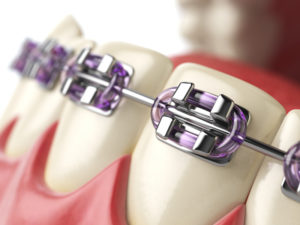
What Does An Orthodontist Do?
An orthodontist is a step above a dentist when it comes to their schooling. To become an orthodontist, a person must complete 4 years of undergraduate schooling at a university. They then apply for dental school and must be accepted. After 4 years of dental school, many students become dentists. However, orthodontists must continue to do at least 2 more years of orthodontic school and fellowships to do orthodontia as a profession.
Even though orthodontists are trained in dentistry, they do different work than dentists. They provide services such as correcting misaligned teeth and smiles, overbite, underbite, crossbite, and other alignment issues. Some are trained to provide surgical orthodontic procedures, or they work closely with an oral surgeon in correcting a misaligned jaw.
For patients who receive surgical orthodontics, an orthodontist will provide pre-surgical orthodontic care to align teeth and jaws as much as possible. A patient will then have oral surgery done to correct issues that can’t be done without surgery. Then, the jaws and teeth are aligned to their final, complete position through orthodontic appliances. If a patient doesn’t receive surgical orthodontics, they generally do 18-24 months of braces to straighten their teeth. Primarily, this is what an orthodontist does: they design braces (based on what type you pick) that fit your smile and that can shape it straight over the course of 1-2 years.
How It’s Different Than Dentistry
Both dentistry and orthodontics focus on oral health and improving a person’s smile. However, dentistry primarily strives to clean the teeth, fix tooth decay, perform root canals and treat gum disease. Patients also receive dental crowns, bridges and implants, and many cosmetic dentistry procedures. If you need teeth whitening or want to improve the look or health of your teeth, seek out a dentist. They can perform teeth whitening services, provide dental veneers and implants, and can help with oral health diseases.
However, if you need your teeth straight in the first place, you need an orthodontist. The American Dental Association recommends that every patient see a dentist at least twice a year to avoid major oral health diseases. You will need an orthodontist at various intervals in your life. However, you don’t see them as frequently throughout life like you would a dentist. When you have crooked teeth or problems with your jaws or alignment, you work with an orthodontist to fix the major issues. Then, a dentist fixes the more minor issues like the color of your teeth.
A dentist is not trained to straighten the teeth even if a dental office provides a transparent aligner service such as Invisalign. You always want to choose a trained orthodontist for properly straightening your teeth so oral issues don’t arise.
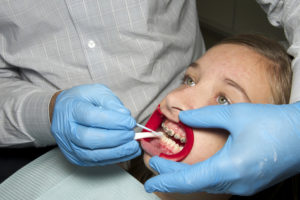
Do You Need Orthodontics?
When battling tooth decay, gum disease, bad breath and more, seek out a dentist. If you want to correct jaw, teeth, alignment, and bite issues, seek out an orthodontist. You may find yourself visiting both often if you receive braces as a child and then later as an adult or teen. Most orthodontists are trained to correct jaw and bite problems in children. You should always take your child in to see an orthodontist by age 7 if you already haven’t. The American Association of Orthodontics recommends this, as major bite and alignment issues of the jaws and teeth can be corrected easily when young. As a person grows older, the jaw hardens and becomes more permanently fixed, and oral health problems are much harder to correct.
If you are deciding to invest in braces, take a look at your teeth. Are they crooked? Do you find that either the upper or lower jaw overlaps the other significantly? Do you have problems speaking, eating, biting or chewing at times? You could benefit from orthodontics! Most people can significantly improve their oral health and their happiness (from having a beautiful smile) if they choose to see an orthodontist for help with their smile.
Dr. Hardy’s Office
Dr. Hardy is an award-winning orthodontist in Lakewood, CO. He is an active member of the American Dental Association and the American Association of Orthodontics. Dr. Hardy works with a team every day to make sure his patients young and old are cared for. At his center, he offers patients the option of getting ceramic, clear braces, traditional metal braces, lingual braces and Invisalign treatment. He can perform surgical orthodontics if needed and pediatric orthodontics. When choosing a center for your family, you want one that can treat patients of all ages and a center whose staff knows how to work really well with children. You can find that at Dr. Hardy’s Belmar Orthodontics office by calling (303) 225-9016!
Prevent Tooth Enamel Problems During Braces with Proper Orthodontic Care
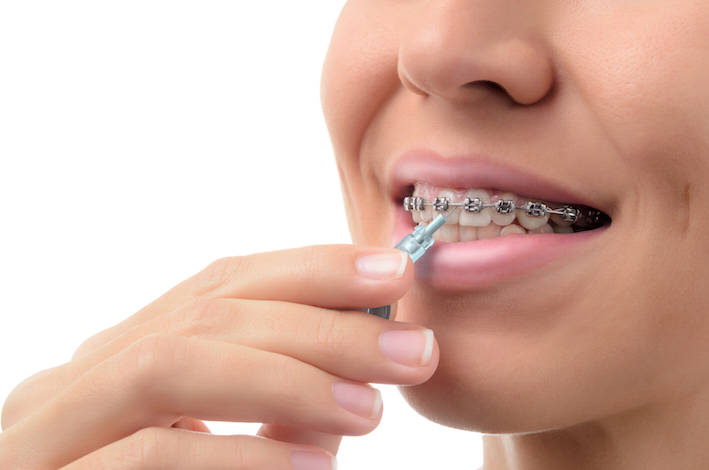
There are many oral health problems that can happen with braces if you are not focused on your orthodontic care and brushing/flossing of your teeth. Your diet can damage your teeth during your orthodontic treatment, which is why we want you to avoid certain foods and drinks. Your diet can damage your teeth during your orthodontic treatment, which is why we want you to avoid certain foods and drinks. Overly acidic or sugary foods and drinks can lead to tooth decay and acid erosion that harms your tooth enamel. We can help you to know what foods and drinks to avoid so you don’t have dental problems during your time with braces!
Increased Risk of Tooth Decay When With Braces
Braces provide patients with a spectacular tool for straightening smiles and correcting jaw problems that impact self confidence and overall oral wellness. Technology has improved over the years allow for less and less of an apparatus on the tooth enamel, but, nonetheless, there is still an apparatus sitting on your teeth for the duration of your treatment. Unless you are wearing removable Invisalign aligners for your orthodontic treatment, your apparatus will consist of wires and brackets. Your wires and brackets are fundamental to the treatment process, but they also can make it difficult to remove food particles that get stuck under, between and in your brackets and wires. If this food is left to fester, the acidic content of the food can eat away at your tooth’s vital tooth enamel.
Combat this type of tooth decay by using the tools your orthodontist recommends for cleaning your teeth. This includes regular brushing, an interdental brush, floss (and floss threaders) and possibly a water flosser to help you use the force of water to rid your mouth of stuck debris.
Acidic Foods and Drinks Erode Tooth Enamel
When it comes to taking care of your teeth with braces, one of the best things you can do is pay attention to what you are putting in your mouth. Thinking about what is coming in contact with your pearly whites can protect your teeth from erosion and decay.
Certain foods and beverages are more acidic (eroding) than others. Low acid foods are better for your teeth even though some of their high acidic counterparts are good for your body. During orthodontic treatment, focus on eating foods that are BOTH good for your body AND your teeth.
Less tooth-friendly foods and drinks include: apples, cherries, oranges, peaches, pears, plums, pineapples, raspberries, tomatoes, pickles, soft drinks, fruit drinks, vinaigrette dressings, BBQ sauces and salsas.
More tooth-friendly foods and drinks include: bananas, mangoes, melons, carrots, cucumbers, lettuce, beets, milk, water, meat, poultry, seafood, eggs, crackers, soups and pasta.
Orthodontic Care: Cleaning Teeth at Home
If ever there was a time to skimp on your oral hygiene it is NOT when you have braces. Diligent home care can make a significant difference in your smile results post-orthodontic treatment. Here are three steps to follow to help you find success:
- Brush after every meal. Because your braces can easily attract and trap food particles, brushing after each meal can help prevent staining and reduce the potential for bacteria buildup. To brush teeth with a regular soft brush, brush down from the top, then up from the bottom on each tooth with a bracket.
- Use a threadable floss or a floss threader. (If using a floss threader, thread regular floss through the eye of the threader, the same way you would with a sewing needle and thread.) Using the small or the pointed end, insert the floss or floss threader between the teeth, but below the archwire. Gently move it back and forth until it is able to thread the floss between the teeth. Once in place, you can floss the two teeth on either side of where you have inserted the floss, taking care not to apply force or pressure against the archwire. Repeat between all teeth.
- Use a proxabrush (interdental brush). After brushing with a toothbrush, use a proxabrush, commonly referred to as a “Christmas tree brush,” to clean between each bracket. Place the proxabrush between two brackets, below the archwire, brushing up and down. After several strokes, repeat this motion by inserting the brush from the opposite side (either down from the top or up from the bottom).
If you are having ANY difficulties cleaning your teeth with these above tools, contact our office so we can help!
Schedule an Orthodontic Care Consultation to Protect Your Tooth Enamel
Your time with braces will come and go in a flash, although you might not believe that in the beginning. The efforts you make from day one with your braces to protect your tooth enamel will show in the results of sparkling, white, strong, healthy teeth. Our friendly staff at Belmar Orthodontics is available to train you in methods and tools for keeping your teeth clean and strong. Make sure to keep your regular cleaning and check-up appointments so we can examine your teeth and make suggestions for improvements. Make an appointment by contacting our office today at 303.225.9016. We are excited to meet you and help you reach your smile goals!
Choosing a Good Orthodontist
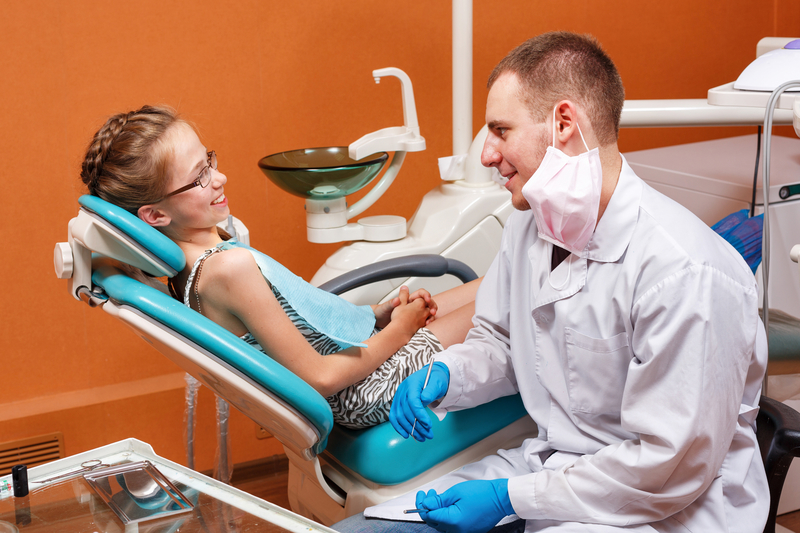
There are many orthodontists out there, but not all are created equal, and not all have the same training or experience as others. Just like dentists, only some are award-winning orthodontists (for good reason), while others are not. A good orthodontist needs to have specific training and credentials to work on your or your child. Their office needs to have specific equipment to perform the necessary work, and a good orthodontist will provide a wide range of services for their patients. Find out what a good orthodontist looks like and how to choose a good one from one you want to avoid!
Choosing to Receive Braces
If you have made the choice to get braces, we commend you! Braces is an amazing way to change your life for the better. Studies show that straightening your smile is directly related to increased confidence. The better a person’s smile looks, the more they smile and the more confident they appear to others as well. Studies by Invisalign and countless others have found that a straighter, more beautiful smile makes you appear happier, healthier, wealthier, and more attractive to others. 73% of people are also more likely to find you trustworthy.
Now that you have chosen to embark on this new journey of getting braces, you have to decide who you should get your orthodontic care from. All too often, dental practices have started offering orthodontics via transparent aligner systems or Invisalign. Even though we offer Invisalign at our center (and it is effective), the majority of dentists are not trained to perform orthodontics. It’s similar to a spa offering botox injections instead of a medical doctor that provides botox injections. They may have some training in oral health and dentistry, but dentistry is not the same as orthodontics.
You always want to choose a trained orthodontist to provide you orthodontic work, and not just a dentist (or even someone without a degree) to perform any work on your mouth. If you do, you take a serious health risk that your teeth will be messed up permanently or that you will have oral health complications. Always go to a certified and trained orthodontist for your orthodontic work.
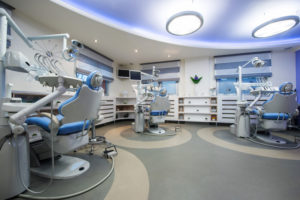
Training to Become a Good Orthodontist
Becoming a good orthodontist takes many hard years. A good orthodontist will receive an undergraduate degree and then will go on to be accepted into dental school. A good orthodontist will receive high marks in their dental school, and will have to be accepted into an orthodontic school afterwards. Some even go beyond their 10 years of base training to do fellowships and additional study. It takes an entire decade to learn how to straighten the teeth properly, even if orthodontic care may seem simple and straightforward.
Orthodontists deal with the health of a person’s mouth, which can affect their overall health, their confidence, and even if they are at risk for tooth decay, gum disease and more. Working with children in orthodontics can be even trickier, as many children require specific work to make space in the jaws for incoming teeth.
What Is Their Experience with Children?
The majority of good orthodontists work with children on a regular basis. However, there are some that have better training than others. You always want to look for a good orthodontist that has training to work with a child on their intellectual level. Children sometimes fear dental or orthodontic office or having work done on their mouth. We strive to provide a child-friendly atmosphere to our young patients to make them comfortable during their treatment.
A good orthodontist is one that can help your child feel at ease and confident about the smile they are getting. When choosing an orthodontist, observe how they act with your child. If they are warm and inviting, this can help children have a positive orthodontic experience for early orthodontic treatment and when they receive braces for straightening later on.
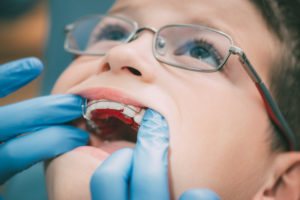
What Qualities Do We Have?
If you want a good orthodontist, give Belmar Orthodontics a try! Dr. Hardy is an award-winning orthodontist that treats patients at two different locations. He has extensive training in dentistry and orthodontics and actually runs a pediatric dentistry and orthodontics office alongside his wife. He treats pediatric patients and older at Hardy Pediatric Dentistry & Orthodontics and he treats patients of all ages at Belmar Orthodontics. Dr. Hardy offers every option available in orthodontics to his patients. That includes traditional metal braces, lingual braces, ceramic braces, Invisalign and Invisalign Teen, as well as retainer devices, TADs, and surgical orthodontics. All of these services required countless hours of training, testing and performance to become certified.
As we mentioned, you want an orthodontist who has won awards and who others are talking about. Dr. Hardy is board-certified by the American Board of Orthodontics. He is also an active member of the American Dental Association and the American Association of Orthodontics. He received the Everett Shapiro Award in Orthodontics as well as the Dr. Harold Berk Endowed prize Fund for Excellence in Research. He is also a member of many dental organizations that you can find here. He is extensively trained to work not only with teens and adults, but also children—even very young ones. Dr. Hardy also works alongside his wife often, who also has extensive training and psychology experience with young children.
We can talk about Dr. Hardy’s qualifications all day long, but the best way to know what a good orthodontist looks like is to come into the office and see for yourself. To schedule your free consultation or to learn more, call Belmar Orthodontics Orthodontist in Lakewood Colorado today at (303) 225-9016!
Foods and Drinks that Harm Your Teeth
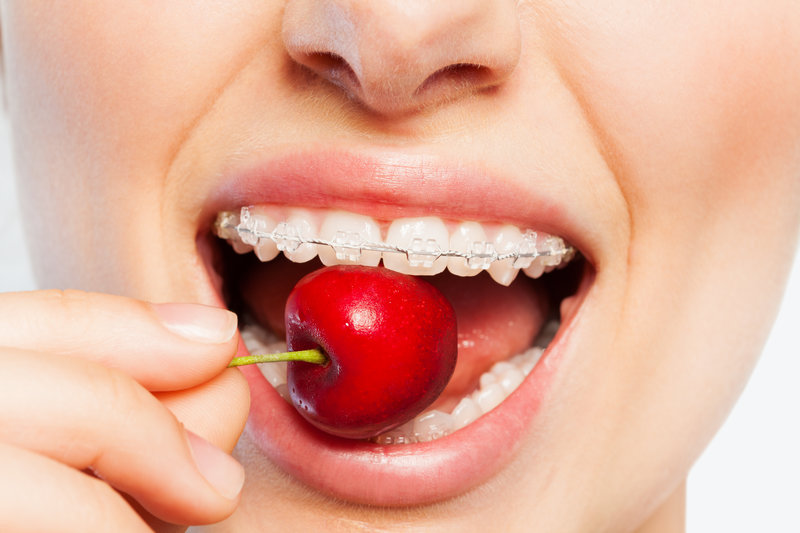
You wouldn’t knowingly do anything to harm your teeth, but are you actively doing things to protect them? Braces are an amazing opportunity to get a straighter, more beautiful smile. However, wearing braces on your teeth make them much harder to clean than they were before. This is especially true when it comes to certain foods and drinks. We have a list of foods that you should avoid during your orthodontic treatment because those foods stick to the teeth. You never want food to stay stuck in your braces, as this leads to tooth decay and demineralization. We can help you to know what foods and drinks to stay away from during your orthodontic treatment. We can also help you to know how to properly clean your teeth so you don’t have to worry about tooth decay as your teeth get straighter. Avoid foods and drinks that harm your teeth so you can have a beautiful smile once those braces come off!
What Does Plaque Do?
When you eat, bacteria in your mouth mix with sugars in the foods and drinks you consume. That creates a sticky, transparent film that coats your teeth. Many people have heard of this sticky substance–plaque–before, but they don’t understand what it does. Plaque is a substance that you make right in your mouth.That sticky film is also acidic, so over time, plaque slowly erodes away your tooth enamel. Brushing your teeth several times a day and flossing regularly can keep plaque from accumulating on your teeth.
Foods that Harm Your Teeth
When it comes to having that healthy, beautiful smile, take a proactive approach by avoiding foods that are known to damage your teeth. Some foods damage your teeth because of what they contain or by what you do with that food. Here are some foods that can harm your teeth:
- Hard Foods – Be careful when eating hard foods such as carrots, nuts, popcorn hulls, hard candies and more, as you could break or chip a tooth.
- Sugary Foods – Foods with sugar help make more plaque in your mouth. The more sugar there is, the more plaque you can make. Limit your sugar intake to help keep your mouth healthier.
- Chewy Foods – Chewy foods such as gummies, taffy, caramels and more, stick to the teeth more than other foods. That means sugar sits on your teeth for longer, eroding your enamel. Brush your teeth after eating these foods.
- Ice Chips – Although ice is just hardened water, it can break or chip a tooth if you chew on it. Water gets very hard, and often water in the form of ice breaks teeth or wears them down over time.
- Fruits – Whether you have fruits often or fruit juice, they both contain citric acid. Any type of acid is one that you want to watch out for as it will harm your teeth. Citrus fruits such as oranges and lemons will damage your tooth enamel and weaken it over time.
Drinks Erode Tooth Enamel
Drinks can also harm your teeth, and can impact your smile even more than some foods. The average person needs to drink about half their body weight in ounces each day to stay properly hydrated. In an ideal world, people would drink only water or liquids such as vitamin-fortified milk. However, it’s becoming more common for people to consume sugary drinks such as sodas, juices, and energy drinks instead of water. The high-sugar content of these types of drinks can quickly damage your teeth.
Drinks to Consume in Moderation
There are many types of drinks. Some of the most common drinks that damage your teeth are:
- Sodas – One of the worst culprits of drinks that harm your teeth is soda. These not only are full of sugar, but they also contain carbonation. Carbonation gives you that fizzy pop in your mouth because the CO2 in the carbonation has a chemical reaction in your mouth. This turns that CO2 into carbonic acid, which erodes away your tooth enamel. If you want stronger teeth, skip the soda.
- Sugary Drinks – Sports drinks provide electrolytes, which help keep your muscles working, your energy higher and help you recover better. However, they are full of sugar, which will damage your teeth. Juices aren’t any better either. Always check your drink label for the sugar content and avoid drinks with lots of sugar.
- Energy Drinks – Think of these as a step up from sodas. Most energy drinks contain carbonation, although you can find options that are non-carbonated. However, most energy drinks work overtime to harm your teeth. Energy drinks generally give you a boost of energy through caffeine. Most energy drinks also add in much more sugar than a regular soda would (which is already a lot). Save your teeth and get more sleep or exercise for energy.
- Additional Beverages – There are many drinks that can harm your teeth. Water can harm your teeth if it is carbonated, because of the acid that is involved. Milk is great for your teeth, as it contains calcium and phosphate, which can help rebuild your tooth enamel. However, chocolate milk is full of sugar, which harms your teeth. With any drink, always check the label to know what you are actually drinking.
Use Mouthwash for Added Defense
Mouthwash can kill bacteria that help make plaque in your mouth. Fluoride fights against the damaging effects of plaque. Incorporate it in your cleansing routine to help fortify your tooth enamel and protect your mouth from tooth decay.
Establish Good Habits
Practice good habits to promote great oral health. Protect your teeth through proper brushing and flossing practices. The American Dental Association recommends that every person brush their teeth at least twice a day, if not after every meal. The more often you brush your teeth, the less likely you are to have tooth decay and problems such as gum disease.
While flossing requires more steps with traditional braces, it is an essential part of protecting your teeth while wearing braces. Don’t be tempted to skip this important part of your teeth-cleaning process!
See Your Dentist During Orthodontic Treatment
Seeing your dentist for comprehensive exams and dental cleanings twice a year during your time with braces will also help you to know how healthy your mouth is. Your dentist can give your teeth a thorough cleaning and teach you tips for better oral care with braces.
Call for a Consultation
If you would like to know more about foods and drinks and how they affect your teeth, or if you would like to schedule a complimentary consultation at Belmar Orthodontics, please call our office at 303-225-9016. We are anxious to keep your smile bright and healthy throughout your time with braces and after!
Dental Care during Braces
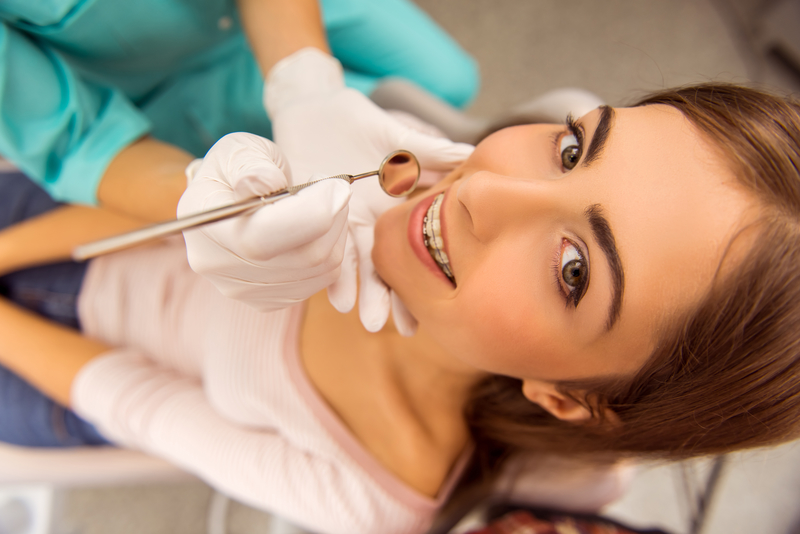
An orthodontist has been to dental school and is skilled enough to spot gum and teeth problems. However, seeing an orthodontist is not enough to keep your teeth healthy. During your time receiving braces, it’s also important to keep seeing a dentist for cleanings, exams and dental treatments. Learn why dental care and oral hygiene is important during your time with braces and how it can help you have a better smile after your braces!
Caring for Metal Braces
Your dental care during braces will depend on the type of braces you receive. If you choose metal braces, brackets and wires in your mouth make it easier for food particles to get stuck. This quickly leads to dental issues if proper care is not taken. You have to be meticulous about cleaning away plaque and stuck food particles so that you avoid tooth decay and demineralization of your tooth enamel. You do this by:
- Brushing after every meal. Your braces easily trap food particles every single time you eat. Brushing after each meal can prevent staining and reduce the potential for bacteria buildup. When brushing, make sure you have a regular, soft-bristle brush. Brush down from the top, then up from the bottom on each tooth that has a bracket.
- Using a threadable floss or floss threader. You will quickly notice that you can’t floss the conventional way with metal braces because the archwire is in the way. If you use a floss threader, thread regular floss through the eye of the threader like you would a sewing needle and thread. Or, using threadable floss, insert the small or pointed end in between your teeth, pulling it through. Once in place between your teeth, you can floss the two teeth on either side of where you have inserted the floss, taking care not to apply force or pressure against the archwire. Repeat between all teeth.
- Using a proxabrush. This is a small brush that looks like a Christmas tree. Place the proxabrush between two brackets, below the archwire, brushing up and down. After several strokes, repeat this motion by inserting the brush from the opposite side (either down from the top or up from the bottom).
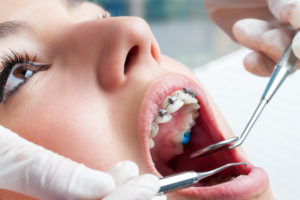
Dental Care with Other Braces
There are other types of braces besides metal braces. At our office, we also offer Invisalign, lingual braces and ceramic braces.
- Ceramic braces – Care for ceramic braces is the same as for traditional metal braces. This is because the design of these braces are the exact same, except they are made out of white, ceramic material.
- Lingual braces – These braces consist of brackets and wires that are placed on the tongue-side of your teeth (meaning behind the teeth). You will have to be more careful with brushing and flossing your teeth, as you won’t be able to see the brackets and wires as well. However, cleaning is very similar to how you would clean metal braces. With flossing, floss threaders will become your best friend, and you’ll want to be meticulous with this because food can get stuck more often with the braces being inside your mouth by your tongue.
- Invisalign – This orthodontic appliance is completely different than the other options you have. Invisalign is a series of transparent aligners that you switch out every week. The benefit of these aligners is that you can easily remove them, and brush and floss your teeth like normal. No brackets, wires or lengthy flossing session. When you take the aligners out, rinse them to get the saliva off of them. Then soak them in a retainer/braces cleaner. An example is Retainer Brite or denture cleaner.
Do You Need to See a Dentist?
Did you know that an orthodontist must complete dental school. In order to practice orthodontics, they need to complete a 4-year bachelor’s degree followed by 4 years of dental school. After that time, an orthodontist will continue 2-3 years of additional training and schooling to practice orthodontics. Therefore, an orthodontist knows what a dentist knows when it comes to your oral health. However, one point that we want to stress is that you need to continue seeing the dentist during your time with braces.
An orthodontist is skilled at treating issues with your oral health, however, an orthodontist is in charge of correcting bite and alignment. A dentist is the one that will need to correct problems with tooth decay and gum disease. Even though an orthodontist has received the same training, their profession is to not to fill cavities or do root canals unless their practice does both. During your time with braces, you must continue receiving dental care from a dentist. Braces raise your risk for tooth decay and gum disease
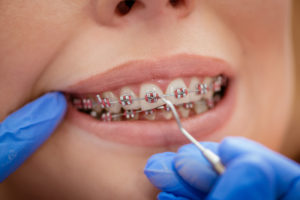
Dental Care during Your Time with Braces
Your dental care during braces will depend on the type of braces you receive. Many patients choose traditional metal braces for straightening their teeth. No matter what orthodontic option you choose, it is particularly important to maintain great dental care through attention to proper oral hygiene. If you don’t know what that proper hygiene routine looks like, we can help you. As always, if you have any questions about braces care or maintenance, please do not hesitate to contact our office. We are here to help you reach your goals and to keep your mouth healthy. For help caring for your braces, or if you are finding certain oral hygiene tasks difficult, call Belmar Orthodontics at (303) 225-9016!
Orthodontic Treatment and Pain Management

One of the most common questions orthodontists receive is “will it hurt?” The answer to this question varies between patients because every mouth is different, and everyone has different perceptions of pain or discomfort. Yes, braces make the teeth and tissues sore. The good news is that orthodontic patients respond well to simple pain management strategies. The discomfort associated with orthodontics is also not felt throughout the duration of treatment. Temporary discomfort occurs when braces are tightened, or when teeth undergo an increase in pressure to shift them into a new position. Learn more about pain management when you have occasional braces discomfort and how to make your experience more comfortable.
Receiving Braces
As you become accustomed to your new braces, your teeth will likely be tender and you may experience a dull ache for the first 2-4 days. Remember, you just had brackets cemented to each tooth, which is bound to cause discomfort. The reason for this discomfort isn’t completely understood. However, research has shown that when pressure is applied to the teeth, it changes your blood flow. You body also secretes certain proteins such as “substance p” and “prostaglandins”. This applied pressure of the brackets and archwire basically triggers the body’s inflammatory response—the same response you feel when you’ve injured a part of your body.
We recommend that our patients eat soft foods during this initial adjustment period. Often, patients need pain management methods after each time your braces are tightened as well. If needed, you can use an over-the-counter pain reliever such as Tylenol. Some of our patients also find a warm saltwater rinse helpful for pain management. Accessory appliances such as rubber bands, springs or headgear also cause teeth to become sore in some patients. When wearing these appliances as prescribed, your sensitivity will typically go away in 2-4 days or even sooner.
Does Your Braces Type Matter?
There are several different types of braces you can receive to straighten your teeth. All of the orthodontic treatment methods we have will most likely make your teeth a little bit sore. This is because your teeth are moving into a straighter position. In order for them to move, there will be discomfort, and that discomfort will be similar with the different braces options you choose. The braces options we offer for your orthodontic treatment include: traditional metal braces, lingual braces, ceramic braces and Invisalign.
We wish that we could say you will never have discomfort with your braces. However, you are moving the position of your teeth, which has been permanent up until the point where you chose to receive orthodontic treatment. Moving something permanent is bound to cause a little bit of discomfort, however, that discomfort generally last less than a day. Some patients don’t feel discomfort at all or don’t with every braces adjustment.

Orthodontic Treatment Options
- Metal Braces – Metal braces are the most common type of braces. They are made out of metal brackets attached to the center of each tooth. A metal archwire connects these brackets that are cemented to the teeth. When you come in for your braces adjustment, we will tighten your wires. Your teeth shift constantly and the wires need to be adjusted accordingly. We will adjust your wires each time you come in. The adjustment is slight, but may cause you discomfort. This generally lasts for only the first 24 hours (if at all). We often use rubber bands to bring crooked teeth into place. You may feel discomfort with these rubber bands as well, but only for a similar short time period.
- Ceramic Braces – These braces are very similar to traditional metal braces, except that the materials are made out of ceramic. This helps decrease demineralization that generally happens to the teeth with metal braces. The structure of this type of orthodontic treatment is very similar, so patients can expect about the same level of discomfort (if any) as they would with metal braces. Pain management strategies are the same for these types of braces as well as for lingual braces.
- Lingual Braces – These are metal braces attached to the back of each tooth. Traditional metal braces are attached to the front of the tooth, and lingual braces are attached to the back. This will create a slightly different experience when the wires are adjusted at an orthodontic visit. A patient may feel that their teeth are more sore on the back than the front. This is because the metal is bonded to the back of the teeth instead of the front. However, discomfort is minimal and will go away quickly.
- Invisalign – Invisalign is a series of transparent aligners that work to shift your teeth into place. Even though they don’t involve brackets, they are a type of retainer that shifts your teeth. You replace these aligners every 1-2 weeks, so you can expect some discomfort every time you change your aligners. However, if you replace your aligner at night, you can sleep through most of the adjustment period where patients typically experience discomfort.
Pain Management with Braces
Pain management is easy when it comes to braces. Millions of people receive braces each year and millions deal with slight discomfort, if any. It’s typical to be slightly sore after receiving braces or an adjustment. However, if you have a braces emergency, come into our office immediately. An emergency consists of: lip and cheek sores, loose bands and brackets, pokey archwires, loose or missing elastic tie, or accidents that caused trauma to your mouth. Many patients find that having their braces is a breeze, and the beautiful smile they receive at the end is quite worth the time it takes with braces. If you have more questions about pain management with your braces, call Belmar Orthodontics today at (303) 225-9016!
Products that Make Cleaning Braces Easier
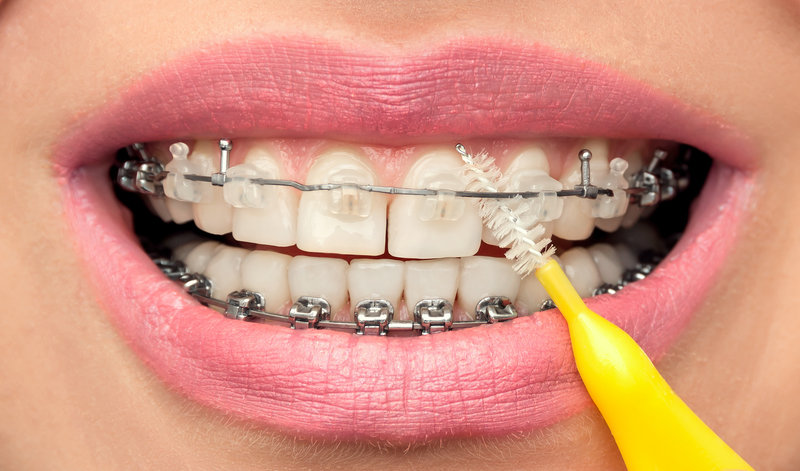
Cleaning the teeth can be hard at times. Cleaning braces on the teeth can be even harder because of all the appliances attached to the enamel. Proper care must be taken with brackets and wires to ensure that all food is removed from the teeth. Brushing and flossing in general helps decrease your likelihood for tooth decay, gum disease, and other oral health issues. Brushing and flossing is different for a smile with braces. There are more guidelines for proper oral hygiene with orthodontic care. Thankfully, there are also products out there (such as flossers) that help make cleaning braces and your teeth easier. Find out how to properly care for your braces and what products can help make cleaning braces easier!
Braces Are Unique to Each Person
Millions of adults will receive braces each year. In fact, there are about 4.5 million people wearing braces annually. In the past, those braces used to all be the traditional style of metal brackets. However, modern technology now affords patients the options of lingual braces, clear ceramic braces, and Invisalign as well.
- Lingual Braces – Many patients want the strength of metal brackets without the braces being so noticeable. Lingual braces are perfect for these patients, as the metal apparatus is attached to the inside of your teeth instead of the outside. You can straighten your teeth without anyone knowing!
- Clear Ceramic Braces – There are other patients that love metal brackets but don’t want the metal to overwhelm their face. Clear ceramic braces are a great option for those who still want brackets, but want them to blend in more with the teeth. Made from ceramic material, these brackets are very durable, naturally help combat demineralization, and are white just like your teeth.
- Invisalign – For a truly invisible straightening system, Invisalign can align your pearly whites discreetly and comfortably. This is a series of removable transparent aligners that you change out every 1-2 weeks. You can take out the aligners for regular brushing and oral care, sports, eating, and more.
Cleaning Braces with Help
It’s vitally important that you take extra good care of your teeth with braces. This is a time when tooth decay can occur in many parts of your mouth. Brackets and wires in your mouth make it easier for food particles to get stuck, leading to other dental issues if proper care is not taken. With braces, we suggest brushing your teeth after every single meal instead of just twice a day. You can use a regular toothbrush, but make sure it is one that you will actually want to use. The toothbrush should have soft bristles so it’s easier on your tooth enamel and the head should fit comfortably in your mouth. Brushing after each meal can help prevent staining and bacteria buildup.
When brushing, brush down from the top, then up from the bottom on each tooth with a bracket. After brushing with your toothbrush, you can get an extra clean by using a proxabrush. This is a special oral health brush that looks very similar to a Christmas tree. It is actually sometimes referred to as a “Christmas tree brush”. You use this small brush by placing it between two brackets below the archwire. Then you brush up and down to dislodge any food you may have missed with brushing or that you didn’t even realize was there. After several strokes, repeat this motion by inserting the brush from the opposite side. For those who want an extra clean, you can use an oral irrigator to blast away food.
What About Flossing?
Many patients have problems flossing the teeth. The main problem is that flossing takes time, and many people either don’t have the time to floss properly, or don’t want to take the time to do it. How well you floss can make quite the difference on what happens to your teeth during your time with braces. Food can easily become stuck in brackets, but we know that food definitely gets stuck between the teeth. This happens even without braces! You may be a pro at cleaning braces, but you also have to be a pro at flossing your teeth with them as well. How do you do this with that pesky archwire that’s in the way?
There are products just for this problem. Use a threadable floss or a floss threader to get the job done. A floss threader is a tool you can use to pull your regular floss through each space between the teeth. Think of a floss threader as a large sewing needle of sorts. You place your floss through the threader. Then, just as a person does with sewing, you will thread the floss threader through each space between the teeth. There is also special floss that has a hard end that is about 2-3 inches in length. Each floss piece can be threaded with the harder end without an additional threader. Every time you floss, make sure to move it back and forth in each space between the teeth, taking care not to apply force or pressure against the archwire.
Cleaning Braces is Easy
You are going to be wearing your braces for 18-24 months, so you’ll have to become comfortable cleaning them efficiently if you want a great smile in the end! Cleaning braces will become second nature to you if you do it often enough. Cleaning braces will help your smile be more beautiful at the end of treatment and will help avoid tooth decay, enamel erosion, demineralization, stains and more. You only get one smile in this life, so treat it right! Many patients benefit from learning more about how to clean their braces and tips and tricks to doing it right and quicker. If you want to learn more about cleaning and caring for your braces, call Belmar Orthodontics today at (303) 225-9016!
Giving Back to the Community
We know just how important orthodontic care is for everyone. A smile can make quite the difference to a child (and even an adult’s) confidence, self-esteem and success in life. Because oral health and straight teeth are so important, we at Belmar Orthodontics participate in various organizations to give back to the community. Smiles Change Lives and Project Smile are just two organizations that give dental services and orthodontic treatments to children, teenagers and adults in need. Learn more about these organizations and how we help make a difference when it comes to orthodontic care.
The Gift of Confidence
If you could give a gift that would benefit someone for the rest of your life, would you do it? There are many gifts that you just can’t put a price on and one of those gifts is confidence. One’s appearance is a main contributor to self-confidence and self-perception. Appearance isn’t always everything, but it can make a difference in perception. The Dental Tribune reported on a study from Invisalign where around 1,000 people on the streets were polled on pictures of people and their appearance. Unbeknownst to those being polled, they were tested on their perceptions between straight and crooked teeth. Pictures of people with straight teeth and with crooked teeth were placed side-by-side. Here’s what the poll found:
- Around ⅓ of the people noticed the teeth immediately, whether they were crooked or straight.
- Around 73% of the people were more likely to trust someone with straight teeth.
- People with straight teeth were 21% more likely to be perceived as happier, 47% to be perceived as healthier and 38% more likely to be perceived as smart.
- The study also showed that people with straighter teeth were found to be more attractive and assumed to be more successful.
These findings all came from the simple perception of how the teeth looked! Because of studies like these and our profession in general, we know just how much a straight smile can affect the lives of everyone who receives one. But what happens when a parent can’t afford orthodontic care for their child? That’s where we come in. We are part of Smiles Change Lives and Project Smile, both of which strive to provide orthodontic care to those who otherwise couldn’t receive it.
Smiles Change Lives
Smiles Change Lives (SCL) helps parents with financial limitations provide orthodontic care for their children. The organization helps them locate orthodontists willing to donate their time and expertise to change smiles via orthodontic care. The organization originally started out as “The Virginia Brown Community Orthodontic Partnership” in 1997 specifically aiming to help improve confidence and self-esteem to children by straightening their teeth. The founder herself grew up in a household that did not have the means to provide orthodontic care for her, which greatly impacted her own self-esteem. Thus, the program seeks to help as many families as possible receive orthodontic care. Since 1997, over 9,000 children have received care through SCL. SCL offsets the full cost of braces, making it so children that otherwise couldn’t afford orthodontic care can receive healthy, beautiful smiles. Dr. Hardy was honored in March 2014 as SCL’s Orthodontic Provider of the Week and strives to provide quality orthodontic care through this organization as well as his everyday work with his patients.
Project Smile
Project Smile works with a similar goal in mind when it comes to providing orthodontic care for those in the local community. However, this organization partners with businesses, organizations, and individuals to meet the urgent needs of local children that need dental and vision care. This organization is locally-based and seeks to strengthen the health of children in the Jefferson County School District. Strengthening the youth in our own city will help those children to grow up with the confidence and health they need to succeed. This project has grown and spread to other local school districts (such as Poudre School District) and will continue to grow with help. Studies have shown that proper dental care helps eliminate tooth aches and pains that lead to decreased focus and decreased learning abilities in children. Problems with vision also contribute to a decreased learning abilities, which is why this organization puts these two services together. No child should have to live with tooth pain or poor vision.
We are always looking for new ways to serve and help our community. We know we can’t help everyone that needs proper orthodontic care, but we know that we can help many. If you want to know more about the ways we give back to the community, or if you have a suggestion for who else we can help, please contact our office today at (303) 225-9016.


